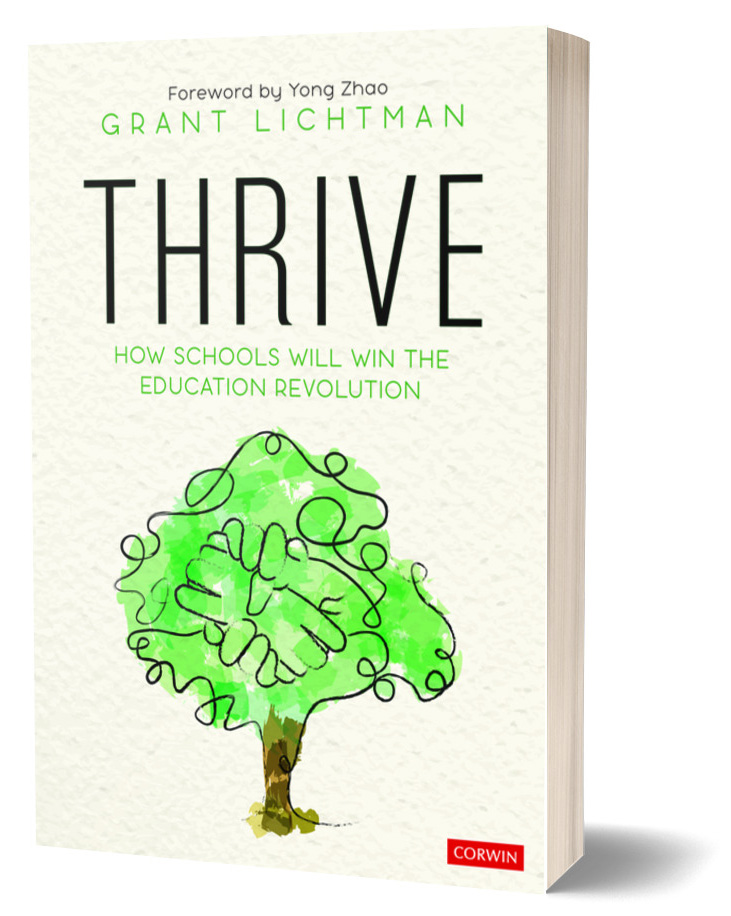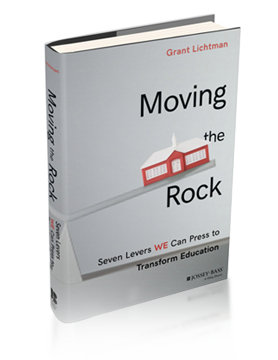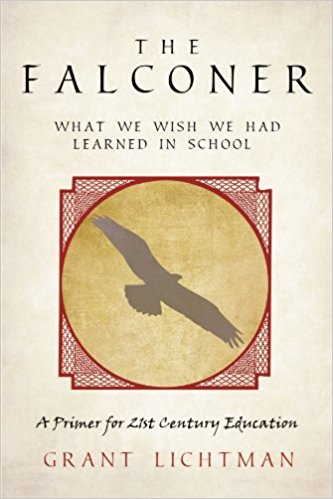
As many of you know, in October John Gulla of the EE Ford Foundation and I launched “If Not Now?” a free, monthly meet-up where we host an especially provocative guest within a fast, interactive 45-minute format. You can still register for future sessions here; we have an outstanding set of guests and topics scheduled through March.
The power of large groups of educators collaborating and sharing, even for a few minutes, is truly remarkable. Our guest in December was Ben Nelson, founder of the Minerva Project and Minerva Schools, which has, in many ways, tipped higher education on its head, and is now influencing secondary schools as well. If you don’t know about Minerva, check it out; it may well be a glimpse into the future of education.
Part of our 45-minute format is a short breakout session where 7-8 attendees (we are getting 150-250 attendees in total) can meet, quickly share ideas related to the guest’s topic, and then post a key takeaway from the breakout discussion. We capture and re-share all of these comments to registrants. If you are not yet registered (why not??), I just want to share with you how many great insights we can collectively generate in about 10-12 minutes, any one of which would probably make a good topic for a leadership team or faculty meeting.
Here is the long list of shared takeaways from our last event. (I took off the attribution from each in case someone did not want their name published, but thanks to all of those who posted a comment.) Hope to see you in January on “If Not Now?”!
- We need to shift from departments with heads to learning architects that use cross curricular scaffolding
- The present crisis presents an opportunity for faster change to purpose-centered educational design.
- How will the disruption of COVID affect the role of standardized testing for college admissions?
- Communities need to be very intentional about the advanced work that should take place prior to moving their program into this direction.
- Is this better than small classes with passionate teachers?
- Take a look at the systems in your schools. Do they allow for centering on competency?
- You need to adjust the culture in advance of adjusting the program.
- Different platforms, i.e., online, create opportunities for innovation that may be more difficult in the more traditional setting.
- The basics are still the basics.
- Heard a lot of concern re: gravitational pull to traditional forms, even among parents of young children.
- We have a chance to drive down the cost of education as we reimagine the high school model.
- Our structures and requirements are dictated by higher ed. Where we have freedom to innovate is in seminars, capstones and internships.
- Interested in how to create a vision that is also inclusive of faculty/student/parent/community perspectives about “what school should be”
- We are focusing more on the concepts of “real world” pedagogy and that seems like a natural bridge to the kind of meaningful competency building we are talking about here
- Idea: Take a risk. For one year, instead of subject based Learning Innovation Teams (science, LA, math, faith formation, social studies) instead organize that innovation work around critical wisdom / Habits of mind.
- Well planned and well executed visioning processes are essential to any effort
- Need to create a “school within a school” (aka Mastery School) to make systemic change? Possible to make systemic change within an existing school?
- Pillar 1 of the work they do at Minerva is continuous professional development for teachers
- Using evaluation as a way to reinforce behavior they want to see in terms of developing critical thinking and wisdom. More opportunities for applied learning in an active way for students
- Focus and simplicity of mission helps immensely with the pursuit of the North Star.
- For us, we have looked at this as a possible public/private partnership model to expand our JK-8 model to a high school model. Easier for us to launch this as a new model as opposed to changing a current culture.
- We did talk about the tension of wanting to provide “excellent” education, as described by Ben, but also, as independent schools “selling” a luxury product (in NYC our K program is $49K – the least expensive in the group
- Our alums come back to us after decades talking about how powerful their experience was — but it’s rarely the curriculum that changed their life.
- I am thinking about those upper school faculty members that won’t entertain another way.
- One thing to do is the re-test experiment on something that has been taught. The results will open up a conversation.
- Authentic learning increases agency in students that results in mastery that is evident
- Sometimes innovating in platform (e.g. going online) forces/allows us to innovate in other, deeper, ways in k-8 schools, what is the balance between basics/skills and real world application?
- Explore non -traditional transcripts but must involve the college level admission offices.
- There remains the challenge of identifying and passing along things of value about our students (who may well be generalists) that is translatable to the next institution or occupation.
- This makes sense for many of our schools to be considering.
- If not now, when?
- It sounds both exciting and intimidating to have your entire faculty be on the same page.
- How do we create a shared vision for our school that has been around for 100+ years
- Structural and institutional difficulties exist but COVID has at least opened the door to new ideas.
- Teachers are not trained in curriculum design, especially in a cross-curricular way
- It’s especially valuable to keep this kind of longer term vision at the fore during these complex times, which make it tempting to only focus on the next steps before us. And it is helpful to think about incremental changes that move us towards the Minerva model.
- Addressing culture first has been our approach. We want everyone to say, “finally!” when we make the big changes that we need to make to stay relevant in the future of education.
- The challenge seems to be how do you get the faculty to own this approach when you have a long-established school with a “traditional” education
- It’s interesting to think about what evidence already exists and what more schools need to take the “leap” towards adapting standards and moving towards a new way of looking at school.
- Do parents want something they “know” vs. “great education”?
- I believe in this, but I’m still wrapping my head around the evolution of this at a traditional school. My lingering questions are about the scale of this and ways to train our faculty to believe it in and pursue it.
- I agree with Ben Nelson about the central priority on figuring out the mission and applying knowledge. I’m reminded of Whitehead’s rhythm of learning: romance, precision, generalization. I wish he had spoken about application outside the school walls.
- The importance of teaching students to be critical thinkers and effective communicators – preparing the students to be able to thrive in a rapidly changing and increasingly globalize environment.
- Run a pilot within the school based on parent interest and spotlight this as the future of education and utilize frameworks as Ben references to pursue it!
- Ben got us thinking about spiraling knowledge, not just while kids are with us, but throughout their lives. What do we want our graduates to have built on over the course of their lives, knowledge they can tie back to their time with us?
- Competency based creative assessment tools that focus on real world problem solving and skills that students can readily apply
- The pandemic has highlighted just how much the brick and mortar model does not work for all. We need to move away from our linear, post-industrial models. COVID has given education that opportunity. We Need to ALL move forward
- It seems to me that implementing this method means that teachers must relinquish some power. They won’t have simple ways to assess students as with the current testing regime. Will they be willing to buy in to a system that effectively demotes them?
- Colleges HAVE to remake themselves — let’s inspire them to do so!
- We focused much of our discussion on the need to take great care when introducing/integrating anything “radical”, which is how some of the Minerva initiatives could be perceived.
- Worried about how his applies to preK to 5th grade keys: reading, writing, math and critical thinking. Are these “subjects” ? We cannot not teach them.
- Radical seems tough to transition current system to, vs. starting from a blank slate.
- Prioritizing Intrinsic over extrinsic motivation with regards to learning is a change initiative for both educators and parents. Changing deeply held understandings about learning in legacy institutions is a holistic challenge and must be addressed comprehensively.
- We all seem to face a similar challenge on how to connect parents to the need but challenging work of re-framing of what a meaningful education looks like. Ben’s words resonated – go back to the purpose of education connect it to your mission.
- Must be willing to “jump off the cliff” and try authentic applied learning; How can we build on the past pieces already put forth for learning ie Grant Wiggins work; Charlotte Danielson; project based learning; world class schools, etc?????
- How can we grow as many unique mission-driven schools as possible – each of them growing from the soil of their own place and community, each of them making “school choice” more difficult for parents – because each of those schools has a unique recipe for helping students thrive.
- Eat your spinach and you get ice cream. Anybody remember who first pitched that metaphor for grading?
- The need to consider different structures that promote creative collaborative approaches to faculty development outside the traditional department chair model to learning architects and instructional coaches.












Leave A Comment